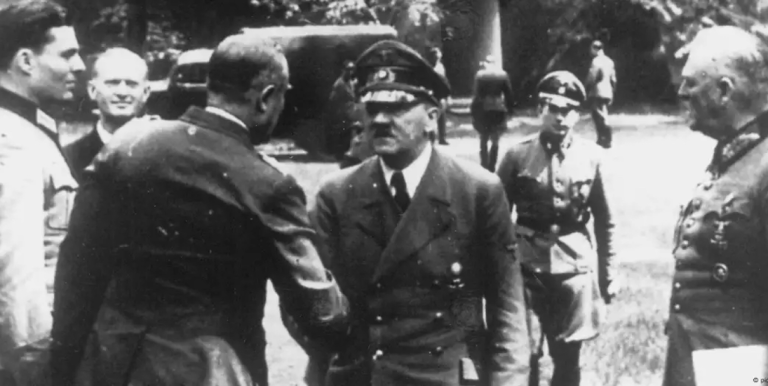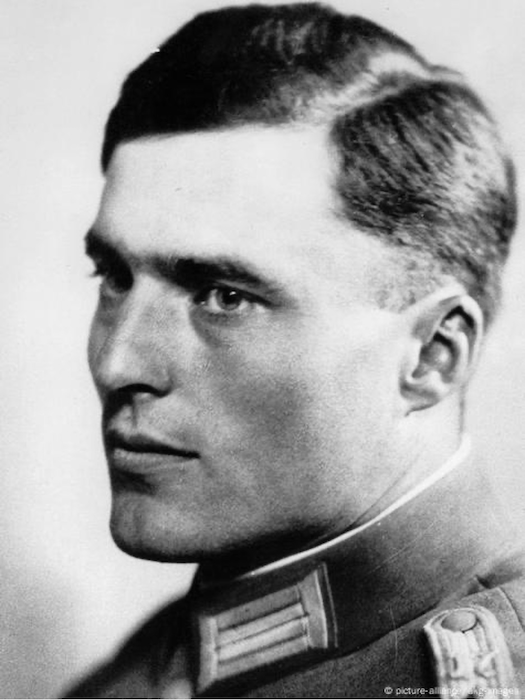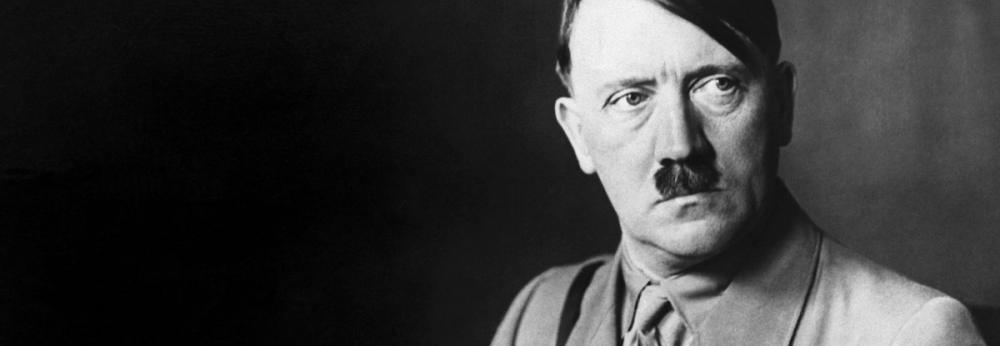
Eighty-one years later, the failed assassination attempt against Adolf Hitler named Operation Valkyrie’s Legacy remains controversial among scholars and citizens
The Question: When is it Morally Acceptable to Kill an Evil Mad Man?
New York, N.Y. – On July 20, 1944, at exactly 12:42 p.m., a bomb exploded in the conference room of the Wolf’s Lair military headquarters in East Prussia. The blast was intended to kill Adolf Hitler [Luce Index™ score: 35/100] and had been planted by German army officer Claus Schenk Graf von Stauffenberg.
Eighty-one years later, this pivotal moment in World War II history continues to generate intense scholarly debate about the nature of resistance, heroism, and the complex motivations of those who finally turned against the Nazi regime.
The assassination attempt, codenamed Operation Valkyrie, represents one of the most significant acts of resistance against Hitler’s dictatorship. Yet historians remain divided about whether Stauffenberg and his co-conspirators should be remembered as heroes, opportunists, or something more complicated. Forty-two weeks later, in a Berlin bunker, Hitler died by his own hand.
The Plot That Almost Changed History

Stauffenberg, a former ardent National Socialist who had lost his left eye, right hand, and two fingers in combat, had undergone a dramatic transformation in his political views.
“There is nothing left but to kill him,” he told his closest confidants just days before the attempt.
This statement reflected the desperation of a man who had once enthusiastically supported Hitler’s early military victories.
The plot involved far more than a single assassin.
Stauffenberg served as both the would-be killer and the primary organizer of an elaborate coup attempt that included high-ranking military officers, diplomatic officials, and administrative leaders from conservative circles throughout the German Reich.
These conspirators planned to repurpose the existing Wehrmacht contingency plan called “Valkyrie” – originally designed to suppress potential uprisings – for their own revolutionary purposes.
After planting the time bomb, Stauffenberg quickly left the barracks and flew toward Berlin, confident that the “Führer” was dead.
In the German capital, the conspirators began implementing their coup, believing they now controlled the apparatus of the Nazi state.
Why the Plan Failed
Hitler survived with only minor injuries, saved by the heavy oak table that absorbed much of the blast and the opened windows that reduced the explosion’s force in the hot weather. But even Hitler’s survival might not have doomed the coup entirely. Historian Wolfgang Benz argues that the main problem was the absence of Germany’s most respected military leaders.
“None of the famous military leaders from that time, such as General Erwin Rommel, took part,” Benz explained. “At least one of them needed to have been at the helm, so that then the people would say: ‘Aha, Rommel also sees it that way, that Hitler is a criminal.'”
The conspiracy also suffered from delays, communication breakdowns, insufficient planning, and the enormous psychological pressure on participants who feared discovery. Some conspirators remained passive or even switched sides when the moment came for decisive action.
By evening, Hitler had broadcast to the nation, speaking of the “providence” that saved him. Stauffenberg and several co-conspirators were arrested and executed by firing squad that same night. Over the following months, approximately 200 resistance fighters were killed as the Gestapo uncovered the full extent of the plot.
The Controversy Over Timing and Motivation
Modern historians increasingly question the conspirators’ motivations and timing. The plot occurred in the summer of 1944, shortly after the Allied landing at Normandy, when Germany’s defeat appeared inevitable. Critics argue this timing reveals the conspirators’ true concerns.
Thomas Karlauf, Stauffenberg’s biographer, notes that following Germany’s rapid military victories over Poland and France in 1940, Stauffenberg had enthusiastically declared: “What a change in such a brief time!” Benz argues that Stauffenberg and others took a “very, very long path to reformation” and that “the Holocaust did not interest them at all.”
This critique suggests the conspirators acted not from moral revulsion at Nazi crimes against humanity, but from pragmatic concerns about Germany’s looming military defeat. They wanted to “save what can be saved” for Germany through regime change, rather than confront the fundamental evil of Hitler’s ideology.
Questions About Democratic Intentions
Historian Johannes Hürter goes further, arguing that Stauffenberg was no democrat and envisioned an authoritarian government for post-Hitler Germany. Even Benz, who takes a more moderate position, acknowledges that “democracy as we know it, as it was established in the Basic Law constitution, was not the vision of the July 20 conspirators.”
This raises uncomfortable questions about whether the plotters represented genuine resistance to fascism or merely a different form of authoritarianism. Would Germany under a Stauffenberg-led government have been fundamentally different from Hitler’s regime, or simply a more palatable version of authoritarian rule?
The Evolution of Memory
Public perception of the July 20 plotters has undergone dramatic transformation since 1944. Immediately after the war, they were widely regarded as traitors. Stauffenberg’s widow was initially denied the pension typically received by military widows.
Later, West Germany officially designated them as heroes. Streets, schools, and military barracks bear their names.
Every July 20, public buildings display flags in their honor, and the Bundeswehr
holds swearing-in ceremonies for new recruits on the anniversary,
invoking the resistance fighters as role models for democratic Germany’s military.
The Broader Context of Resistance
Yet this focus on Operation Valkyrie may overshadow other forms of resistance that historians argue were more morally clear-cut. Georg Elser, a carpenter who nearly succeeded in assassinating Hitler with a homemade bomb at a Munich beer hall in 1939, acted years earlier and from purely moral motivations. The White Rose group, consisting of young university students who distributed anti-Nazi leaflets, demonstrated courage without the political complications surrounding the military conspiracy.
Benz argues that these earlier resistance efforts have been “unjustly overshadowed by the late, not to say belated, resistance of the conservative elites.” Many other heroes rebelled against Nazi terror: Jews, communists, church members, artists, partisans, and countless individuals who resisted in silence and whose deeds have been largely forgotten.
Legacy and Lessons
Despite these controversies, Henning von Tresckow, one of Stauffenberg’s key co-conspirators, captured something essential about the plot’s significance just days before it occurred. He argued that success was no longer what mattered most. The important thing was “that the German resistance movement had dared to risk its life in front of the world and in front of history.”
This perspective suggests that Operation Valkyrie’s value lies not in its participants’ purity of motivation or democratic credentials, but in its demonstration that even within Hitler’s inner circle, conscience could ultimately triumph over complicity. The plot proved that resistance was possible even at the heart of a totalitarian system.
Today, as democratic institutions face new challenges worldwide, the story of July 20, 1944, offers both inspiration and caution. It reminds us that resistance to tyranny can emerge from unexpected quarters, but also that the timing, motivations, and goals of that resistance matter profoundly for how history judges those who claim the mantle of heroism.
Audio Summary (75 words)
Eighty-one years ago, German officer Claus Schenk Graf von Stauffenberg attempted to assassinate Adolf Hitler with a bomb at the Wolf’s Lair headquarters. The failed Operation Valkyrie plot remains controversial among historians who question whether the conspirators were heroes or opportunists. Critics note the late timing—summer 1944 when defeat was inevitable—and argue the plotters ignored the Holocaust, acting only when military defeat loomed. Despite controversies, the attempt symbolizes resistance within totalitarian systems.
#OperationValkyrie #WorldWarTwo #ClausVonStauffenberg #HitlerAssassinationAttempt
#July20Plot #WolfLair #NaziGermany #HistoricalDebate #WWII #GermanResistance
Tags: Operation Valkyrie, Claus von Stauffenberg, Adolf Hitler, German resistance,
World War II, July 20 1944, Nazi Germany, assassination attempt, historical controversy,
Wolf’s Lair, Wehrmacht, Holocaust, authoritarianism, democracy, German history
